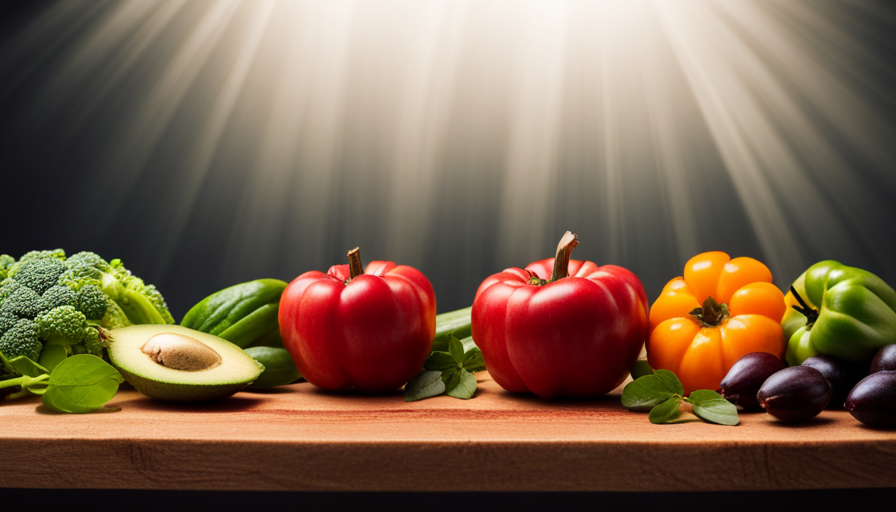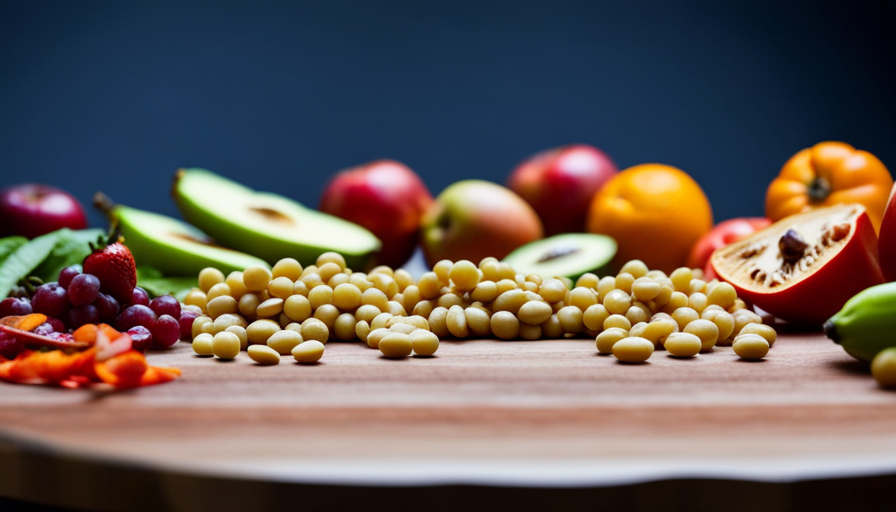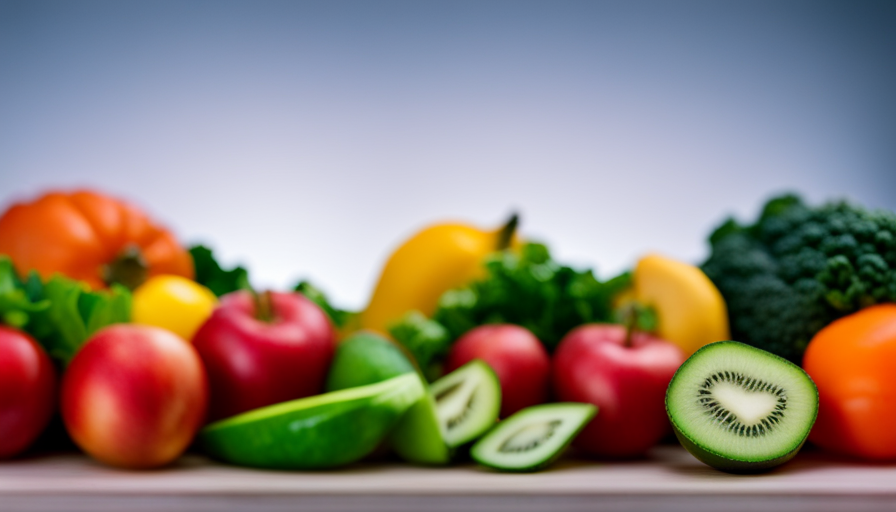Did you know that about 20% of people experience acid reflux regularly? That’s a pretty high number. If you’re struggling with this problem, you may be wondering if eating raw foods is safe. **Stay tuned to discover the answer!**
Acid reflux occurs when the stomach acid flows back into the esophagus, causing discomfort and a burning sensation. While some raw foods can be beneficial for your health, others can trigger or aggravate your acid reflux symptoms.
In this article, we will explore the impact of raw food on acid reflux and provide you with safe options to consider. We will also discuss the importance of portion control, hydration, and lifestyle changes in managing your acid reflux.
If you’re looking for a balanced approach to incorporating raw food into your diet while managing acid reflux, keep reading to find out more.
Key Takeaways
- Raw foods can trigger or aggravate acid reflux symptoms, so it is important to identify trigger foods and find suitable alternatives.
- Certain raw foods, such as citrus fruits, tomatoes, onions, garlic, and peppers, can irritate the esophagus, but they can be replaced with less acidic options like melons, berries, cucumbers, zucchini, green onions, chives, ginger, celery, or carrots.
- Raw fruits and vegetables can reduce inflammation in the esophagus and stomach, and they are generally safe for acid reflux sufferers, but portion control is crucial.
- Cooking raw foods can make them easier to digest and reduce the likelihood of flare-ups, so consulting with a healthcare professional or registered dietitian can provide personalized guidance on managing acid reflux through cooked alternatives.
Understanding Acid Reflux and its Triggers
Do you ever wonder what triggers your acid reflux and if raw food could be one of them? Identifying common triggers is crucial in managing your acid reflux symptoms.
While raw food is generally considered healthy and nutritious, it can sometimes exacerbate acid reflux symptoms. Raw fruits and vegetables are high in fiber and can be difficult to digest, leading to increased acid production in the stomach. This can result in heartburn and discomfort. Additionally, certain raw foods are known to be acidic, such as citrus fruits and tomatoes, which can further irritate the esophagus.
Furthermore, stress plays a significant role in the development and severity of acid reflux. When you’re stressed, your body produces more stomach acid, which can lead to reflux symptoms. Therefore, it’s important to manage your stress levels through relaxation techniques, exercise, and seeking support when needed.
Although raw food can trigger acid reflux symptoms in some individuals, it’s important to remember that everyone’s triggers may differ. It’s essential to listen to your body and identify which foods worsen your symptoms. If you find that raw food aggravates your acid reflux, consider cooking them lightly or opting for other forms of preparation.
Identifying Raw Foods that Aggravate Acid Reflux
Avoiding certain raw foods can help alleviate the symptoms of acid reflux, such as 80% of people experiencing relief after eliminating citrus fruits from their diet. While raw foods are generally considered healthy, some can be problematic for individuals with acid reflux. Identifying and avoiding these trigger foods can make a significant difference in managing your symptoms.
Here is a table showcasing common raw foods that can aggravate acid reflux and some healthier substitutes:
| Raw Food | Healthier Substitute |
|---|---|
| Citrus fruits | Melons or berries |
| Tomatoes | Cucumbers or zucchini |
| Onions | Green onions or chives |
| Garlic | Ginger |
| Peppers | Celery or carrots |
Incorporating these substitutes into your meals can help reduce the risk of triggering acid reflux symptoms. Additionally, there are plenty of raw food recipes that can be enjoyed without aggravating acid reflux. Some options include raw vegetable salads with non-acidic dressings, smoothies made with non-acidic fruits and vegetables, and raw nut and seed-based snacks. Experimenting with these recipes can provide you with delicious alternatives while still maintaining a raw food diet.
Remember, it’s important to listen to your body and identify which raw foods may be aggravating your acid reflux symptoms. Consulting with a healthcare professional or a registered dietitian can also provide personalized guidance and support in managing your acid reflux through diet.
Safe Raw Food Options for Acid Reflux Sufferers
Indulging in juicy melons and refreshing berries can offer a soothing relief for those dealing with acid reflux. When it comes to raw food options for acid reflux sufferers, there are several safe choices that can be incorporated into your diet.
Raw food recipes for acid reflux relief can include dishes such as cucumber and avocado salad or a green smoothie made with spinach, banana, and almond milk.
One of the benefits of a raw food diet for acid reflux management is that it can help reduce inflammation in the esophagus and stomach. Raw fruits and vegetables are rich in enzymes and antioxidants, which can aid in digestion and promote overall gut health. Additionally, raw foods are often lower in fat and processed ingredients, which can be triggers for acid reflux symptoms.
However, it’s important to note that not all raw foods are suitable for those with acid reflux. Some raw foods, such as citrus fruits, tomatoes, and spicy peppers, can actually worsen symptoms. It’s always best to listen to your body and pay attention to how certain raw foods affect your acid reflux. If you notice any discomfort or worsening of symptoms, it may be best to avoid those particular foods.
Incorporating safe raw food options into your diet can offer relief for acid reflux sufferers. Experiment with different recipes and listen to your body to find what works best for you. Remember to consult with your healthcare provider or a registered dietitian for personalized advice and guidance.
The Importance of Portion Control
Take a moment to savor your meal and remember, just like a delicate balancing act, portion control is the tightrope that keeps your acid reflux symptoms in check. When it comes to managing your acid reflux, eating the right amount of food can make a significant difference. Mindful eating and portion control are essential in preventing discomfort and promoting better digestion. Here are some tips to help you maintain portion control while enjoying raw food options:
-
Listen to your body: Pay attention to your hunger and fullness cues. Stop eating when you feel satisfied, not overly full.
-
Use a smaller plate: Opt for a smaller plate to trick your mind into thinking you have a full meal, even with smaller portions.
-
Fill half your plate with veggies: Raw vegetables are generally safe for acid reflux sufferers. They are low in fat and high in fiber, which aids digestion. Create a colorful plate by including a variety of veggies.
-
Be mindful of calorie-dense foods: While raw nuts and seeds can be a healthy addition to your diet, they are also high in calories. Enjoy them in moderation to avoid overeating.
By practicing portion control and mindful eating, you can still enjoy raw food options while managing your acid reflux symptoms effectively. Remember, moderation is key!
Managing Acid Reflux with Cooked Alternatives
To better manage your acid reflux, you can explore a variety of cooked alternatives that provide soothing relief and nourishment. While the raw food movement promotes the consumption of uncooked foods for their supposed health benefits, it’s important to consider the impact of raw food on acid reflux.
Raw foods, especially those high in acidity like citrus fruits and tomatoes, can be triggers for acid reflux symptoms. Cooking these foods can help break down the fibers and make them easier to digest, reducing the likelihood of flare-ups.
Cooked alternatives offer several benefits for individuals with acid reflux. Cooking foods not only makes them softer and more palatable, but it also helps to neutralize the acidity. For example, cooked vegetables are gentler on the stomach and less likely to cause discomfort compared to their raw counterparts.
Additionally, cooking can enhance the availability of certain nutrients by breaking down the cell walls of plants, making them more easily absorbed by the body.
While incorporating cooked alternatives into your diet can be beneficial, it’s important to maintain a balanced approach. Variety is key, as different cooking methods can affect the nutrient content of foods. Steaming, baking, and grilling are generally considered healthier options compared to frying or deep-frying, as they retain more nutrients and reduce the intake of unhealthy fats.
It’s also important to listen to your body and pay attention to how different foods affect your acid reflux symptoms. Consulting with a healthcare professional or registered dietitian can provide personalized guidance on managing your acid reflux through cooked alternatives.
Incorporating Healing Herbs and Spices
If you’re looking for ways to manage acid reflux while still enjoying flavorful meals, incorporating healing herbs and spices into your cooking can be a great option. These natural ingredients not only add depth and complexity to your dishes, but they can also have therapeutic properties that may help alleviate symptoms of acid reflux.
When it comes to healing herbs, there are several options to consider. Ginger, for example, has long been used to aid digestion and soothe the stomach. It can be added to stir-fries, soups, or even brewed as a tea.
Turmeric, another powerful herb, has anti-inflammatory properties that may help reduce acid reflux symptoms. Try adding it to roasted vegetables or incorporating it into a homemade curry.
In addition to herbs, certain spices can also be beneficial for managing acid reflux. Cinnamon, for instance, has been shown to help regulate blood sugar levels and may help with digestion. Sprinkle it on oatmeal or add it to baked goods for a warm and comforting flavor.
Fennel seeds, on the other hand, have been traditionally used as a digestive aid and can be chewed after meals or added to roasted meats and vegetables.
By incorporating healing herbs and spices into your cooking alternatives, you can enhance the flavor of your meals while potentially finding relief from acid reflux symptoms. As always, it’s important to listen to your body and consult with a healthcare professional before making any changes to your diet.
Hydration and its Impact on Acid Reflux
Staying hydrated is crucial for managing and potentially reducing the symptoms of acid reflux. When it comes to acid reflux, water is your best friend. It helps dilute stomach acid and flushes it out of your esophagus, providing relief from the burning sensation. Aim to drink at least 8 glasses of water per day, and try to sip it throughout the day instead of gulping it down all at once.
While hydration is important, it’s also essential to be mindful of what you drink. Caffeine, found in coffee, tea, and some sodas, can relax the lower esophageal sphincter (LES), allowing stomach acid to flow back into the esophagus. This can worsen acid reflux symptoms. Consider switching to decaffeinated drinks or herbal teas that are gentle on the stomach.
In addition to hydration and caffeine, stress can play a significant role in acid reflux. Stress can cause the body to produce more stomach acid and slow down digestion, leading to acid reflux symptoms. Finding healthy ways to manage stress, such as exercise, meditation, or counseling, can help alleviate symptoms.
Remember, staying hydrated and being mindful of your beverage choices can have a positive impact on your acid reflux symptoms. It’s important to listen to your body and make adjustments as needed to find what works best for you.
Lifestyle Changes for Acid Reflux Relief
Making simple changes in your daily routine can bring much-needed relief from the discomfort of acid reflux. When it comes to managing acid reflux, incorporating lifestyle changes can be incredibly beneficial. Here are some tips to help you find relief:
-
Meal planning: Planning your meals in advance can be a game-changer for acid reflux sufferers. Opt for smaller, more frequent meals throughout the day to prevent overeating, which can trigger symptoms. Focus on incorporating acid reflux-friendly snacks such as bananas, apples, and oatmeal, which have been found to soothe the digestive system.
-
Avoid trigger foods: Identify your trigger foods and make a conscious effort to avoid them. Common culprits include spicy foods, citrus fruits, tomatoes, and chocolate. Instead, opt for low-acid alternatives like lean proteins, vegetables, and whole grains.
-
Eat mindfully: Take the time to eat slowly and chew your food thoroughly. This can help prevent overeating and reduce the likelihood of acid reflux symptoms.
By implementing these simple lifestyle changes, you can take control of your acid reflux and find much-needed relief. Remember, everyone’s journey with acid reflux is unique, so it’s important to listen to your body and make adjustments that work best for you.
Seeking Professional Guidance for Dietary Management
When seeking professional guidance for managing your diet, it’s important to know that nearly 75% of acid reflux sufferers report finding relief through personalized dietary recommendations. Consulting with a registered dietitian who specializes in digestive health can provide you with valuable insights and recommendations tailored to your specific needs.
A dietitian can help you identify trigger foods that may exacerbate your acid reflux symptoms and suggest alternatives that are less likely to cause discomfort. While raw food can be nutritious and beneficial for some individuals, it may not be suitable for everyone with acid reflux. That being said, there are raw food alternatives that can still provide you with the necessary nutrients while minimizing the risk of triggering acid reflux.
To emphasize the importance of personalized dietary recommendations, consider the following table:
| Trigger Foods | Raw Food Alternatives | Benefits |
|---|---|---|
| Citrus fruits | Melons | Lower acid content |
| Spicy foods | Raw vegetables (non-spicy) | Reduced irritation |
| Tomatoes | Cucumbers | Lower acid content |
| Chocolate | Raw cacao nibs | Minimal reflux triggers |
Remember, everyone’s acid reflux triggers and tolerances vary. It’s essential to work closely with a dietitian to develop a customized plan that addresses your specific needs and preferences. By incorporating their recommendations and exploring raw food alternatives, you can find a balance between managing your acid reflux and enjoying a healthy diet.
Finding a Balanced Approach to Raw Food and Acid Reflux
To find a balanced approach to incorporating raw fruits and vegetables into your diet while managing your acid reflux, it’s important to work closely with a registered dietitian who specializes in digestive health. They can provide personalized guidance and help you create a meal plan that includes raw foods without exacerbating your symptoms.
Raw fruits and vegetables have numerous health benefits. They’re packed with essential vitamins, minerals, and antioxidants that can support overall well-being. Additionally, raw foods are rich in fiber, which aids digestion and helps prevent constipation. However, some raw foods can be high in acid content, which may trigger acid reflux symptoms in certain individuals.
When incorporating raw foods into your acid reflux-friendly diet, it’s important to choose low-acid options. Some examples include bananas, apples, spinach, cucumbers, and carrots. These foods can be enjoyed raw or lightly cooked to retain their nutritional value. It’s also helpful to experiment with raw food recipes that combine low-acid ingredients in a way that’s flavorful and satisfying.
Remember, everyone’s acid reflux triggers can vary, so it’s essential to listen to your body and pay attention to how different raw foods affect your symptoms. Working with a registered dietitian can provide you with the necessary support and guidance to create a balanced and enjoyable diet that incorporates raw foods while managing your acid reflux.
Frequently Asked Questions
Can raw food cure acid reflux?
Raw food alone can’t cure acid reflux. While some people may find relief from symptoms by incorporating raw foods into their diet, it’s important to note that medication prescribed by a healthcare professional is typically the most effective treatment.
Additionally, following a long-term raw food diet may have its own potential risks and nutritional deficiencies. It’s essential to consult with a healthcare professional to develop a comprehensive treatment plan for acid reflux.
Is it safe to eat raw fruits and vegetables if I have acid reflux?
It’s generally safe to eat raw fruits and vegetables if you have acid reflux. They are rich in vitamins, minerals, and fiber. However, it’s important to choose the right ones that won’t trigger your symptoms. Some raw food recipes can be beneficial for acid reflux, such as salads with non-acidic fruits and vegetables.
It’s always a good idea to consult with a healthcare professional and consider alternative remedies alongside a balanced diet.
How can I incorporate healing herbs and spices into my raw food diet for acid reflux relief?
Imagine your raw food diet as a vibrant garden, where healing herbs and spices are the colorful flowers that provide relief from acid reflux. Incorporating these natural remedies into your meals can be beneficial.
Ginger, chamomile, and licorice root are known for their soothing properties. Turmeric and cayenne pepper can help reduce inflammation. Experiment with these herbs and spices to add flavor and healing benefits to your raw food dishes, all while managing your acid reflux.
Is drinking plenty of water beneficial for managing acid reflux symptoms?
Drinking plenty of water is highly beneficial for managing acid reflux symptoms. Hydration plays a crucial role in overall digestive health, as it helps in the smooth functioning of the digestive system. Water helps to dilute stomach acid, reducing the risk of acid reflux. Alkaline water, in particular, can help neutralize excess stomach acid and provide relief from symptoms.
However, it’s important to note that water alone may not be enough to completely manage acid reflux, and dietary changes should also be considered.
Should I consult a healthcare professional for dietary advice if I have acid reflux?
If you have acid reflux, it’s advisable to consult a healthcare professional for dietary advice. They can provide personalized recommendations based on your specific condition and needs. While there are natural remedies that may help manage symptoms, such as lifestyle modifications and certain foods to avoid, it’s important to have guidance from a professional.
Consulting professionals ensures that you receive evidence-based advice and reduces the risk of exacerbating your acid reflux.
Can Eating Raw Food Aggravate Symptoms of Acid Reflux?
Yes, consuming raw food can exacerbate the negative effects of acid reflux. Raw fruits and vegetables are harder to digest, which can cause stomach acid to build up and lead to discomfort. Cooking these foods can help alleviate symptoms by breaking down tough fibers and making them easier on the stomach.
Conclusion
In conclusion, while raw food can be a healthy choice for many, it may not be the best option for those with acid reflux. It’s important to understand the triggers and avoid raw foods that can aggravate symptoms such as citrus fruits, tomatoes, and onions.
However, there are safe raw food options like bananas, watermelon, and leafy greens that can be enjoyed in moderation. Remember, portion control is key. Interestingly, studies have shown that up to 20% of the population in Western countries experience acid reflux symptoms at least once a week, highlighting the need for dietary management.
Seek professional guidance and find a balanced approach to managing acid reflux while still incorporating raw foods into your diet.

















